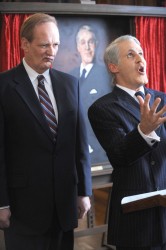 Lip sync is nothing new. It goes back to the very first Holly-wood musicals, only in that case, the actors were singing to their own pre-recorded voices. In Mulroney: The Opera, the voices belong to someone else, and the actors and singers are in two different worlds. Soprano Zorana Sadiq, who sings several roles in the opera, was also the film’s lip sync coach. “It became my obsession,” she says, “to make sure that the actors matched the singers exactly. It had to look like they were using their own voice.”
Lip sync is nothing new. It goes back to the very first Holly-wood musicals, only in that case, the actors were singing to their own pre-recorded voices. In Mulroney: The Opera, the voices belong to someone else, and the actors and singers are in two different worlds. Soprano Zorana Sadiq, who sings several roles in the opera, was also the film’s lip sync coach. “It became my obsession,” she says, “to make sure that the actors matched the singers exactly. It had to look like they were using their own voice.”
When the vocal track was being recorded, the singers were filmed for reference, particularly, how they were shaping their mouths around the words. In the trade, these are called “eye movies.” As well, the actors were given the libretto and their vocal tracks far in advance of the shoot, so they could practise at home in front of a mirror. They also had separate libretto rehearsals. Says actor Rick Miller who played Mulroney: “A big problem was how words are accented. Actors hit the consonants and singers hit the vowels.”
What had to be resolved was the collision of different techniques. Explains Sadiq: “Opera singers rehearse to a ridiculous level to get the music into their bodies. Actors, on the other hand, don’t like to over-rehearse. They like to look spontaneous and are more laid back. As a result, each on-screen performer had to find a way to emulate the pushed, tensed sound of an opera singer.” When the actual shoot was happening, some actors would sing out loud to the recorded track, while others preferred to just move their mouths. It was a matter of personal preference, although Sadiq thought the former was a more practical approach.
Another problem to overcome was the fact that the actors didn’t have a conductor, so on set, they were on their own. Sadiq taught them cheat tricks, like having their mouths opened if they were coming in on a vowel. Or how to mirror vibrato. For example, Patrick McKenna, who played the debate moderator, sung by tenor Eric Shaw, made his chin quiver when he mouthed the words. “Unfortunately, there is no way that one can fake a P,” says Sadiq. “That has to be spot on.”
For very difficult entrances, actors were given a click track on their recorded score, which marks the beat. For example, if they needed to come in on the fourth note, they could count the clicks. The most difficult lip sync was the Shamrock Summit quartet featuring the Mulroneys and the Reagans. With four people singing, it was hard to follow the voices. Each actor had to be given a vocal tape with his/her own part beefed up louder than the other three. Even then, it was problematic to be exact. Says Sadiq: “That’s what editing rooms are for. Clever cuts made the scene work.”



